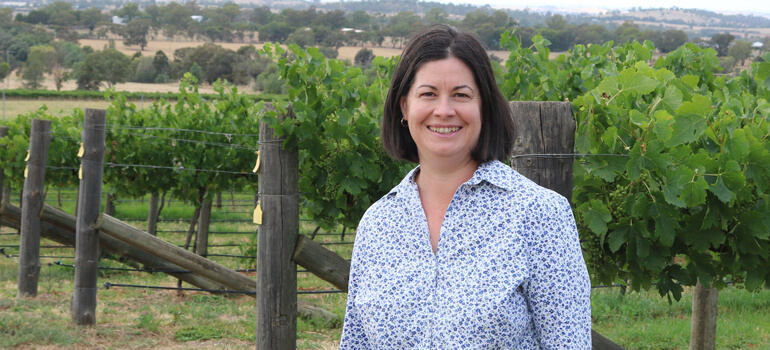For the past few months, Anne Johnson has traversed the hills, roads and rivers of eight New South Wales wine regions, visiting growers and surveying vineyards.
After 30 vineyard visits, and countless conversations, Anne is confident of one thing: growers are increasingly using agroecology – the use of nature’s ecosystem services in farming practices.
“Growers were keen to catch up and chat, and I was encouraged by their genuine interest in improving biodiversity in viticulture; and finding a better balance between viticulture and the environment.
“It was exciting to hear about various trials that growers have underway, ranging from planning new tree lines and cover crops, to making changes to the way they manage their vineyard floor.”

Anne’s interviews with growers are part of her Charles Sturt University PhD research exploring the benefits of agroecology in Australian viticulture – and barriers to its adoption, supported by her 2021 Wine Australia Dr Tony Jordan OAM Award and top-up scholarship.
“As the grape and wine sector adapts to and mitigates the effects of climate change, agroecological practices can improve resilience and sustainability.
“In addition to the biophysical benefits in the field, which are commonly studied, there are many human factors that influence decisions and my research aims to take a holistic look at this to provide a model for future research strategies into social impacts of sustainability that could be extended across the entire sector.”

Anne said most of the changes in practice growers were making were aimed at achieving better disease management, weed management, increases in grape quality and a reduction in costs.
“However, the people I spoke with – whether they were employed to manage a vineyard or owner operators – were all conscious that they are custodians of the land, and that translated to a position of responsibility to leave the landscape in better condition than when they got there.
“In line with this, many are putting in efforts that may not have an immediately obvious economic benefit, but trialling new things with a recognition they can improve on their current practices.

Anne said it was encouraging to see growers excited by the challenge of making change, "especially where the changes match up with growers’ personal values and the direction they want to take their vineyard, these changes are not a burden.”
Anne said two of the themes that came up in conversation again and again were the ideas of balance and minimising interference.
“The concept of balance is used in various ways, from balancing the growth of the vine so not to have too much or too little growth, to balancing economics of the vineyard or their personal life through to the idea that improving biodiversity in the landscape improves the balance between agriculture and the natural environment.
“Growers are keen to improve their biodiversity and establish a balance that will improve their vines, soils and natural environment. This would allow them to reduce the amount of human interference and allow nature’s processes, provided by biodiversity, do more of the work such as natural pest control, nutrient cycling and carbon capture.”
The Dr Tony Jordan OAM Award recognises the most outstanding applicant of Wine Australia’s annual scholarships for postgraduate students in the fields of wine, viticulture, and wine business research. You can read more about it here.
